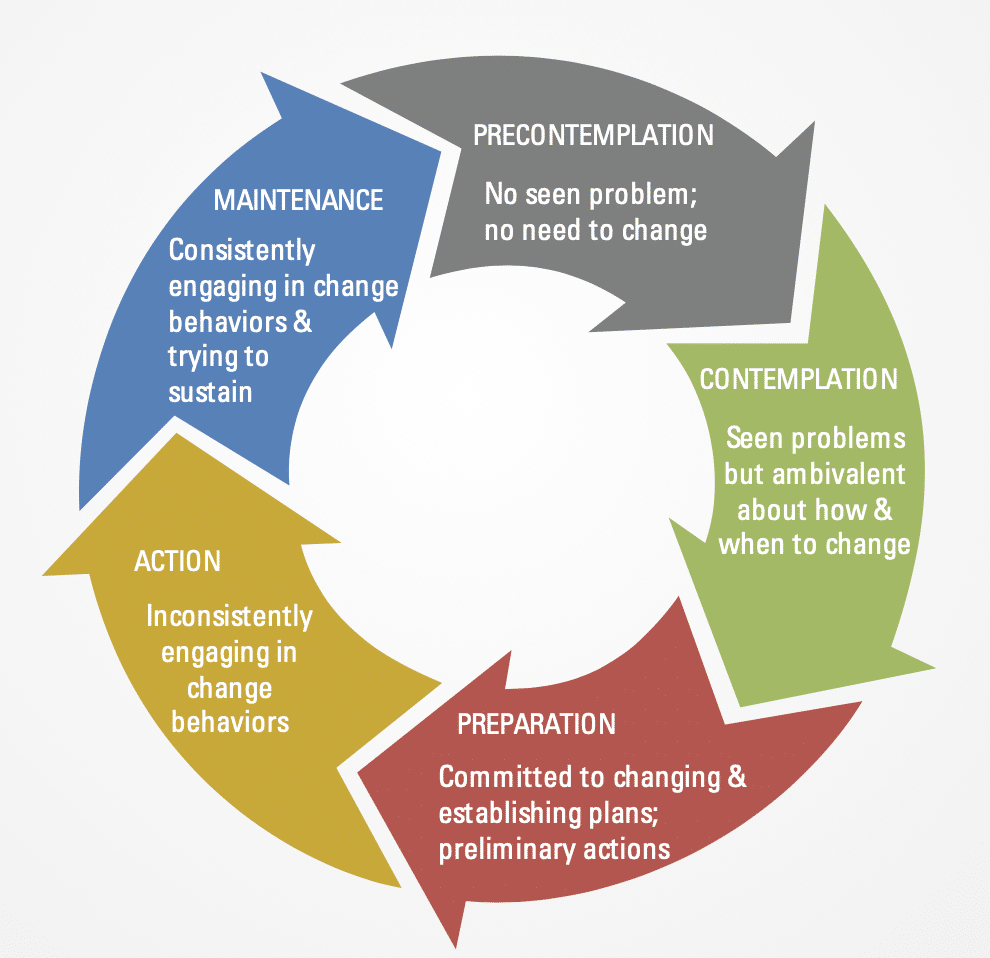'Tis the Season to be Failing: A psychologist's take on why digital transformations and New Year’s resolutions fail
Let’s face the facts: Approximately 80% of New Year’s Resolutions fail. A similar percentage of organizational change initiatives (70%) fail to reach stated objectives. Why?
It starts and ends with commitment issues.
You wouldn’t start making resolutions or proposing an organizational change if you weren’t non-committal to the status quo in the first place. Still, those of you maintaining a relatively stable lifestyle, relationship, career, etc. may have thought you didn’t have commitment issues. However, if you ever experience patterns of not doing what you intended to do when you intended to do it, then your commitment issues are alive and well, and they’re undermining your power to create change at the individual and organizational levels. “Symptoms” of commitment issues include but are not limited to: “snoozing” alarms, starting/ ending work (or your workout) later than planned, procrastinating, burning your food, giving up on New Year’s Resolutions, and mismanaging digital transformations.
The good news – humans have sucked at commitment for a long time, so experts in psychology and business have developed strategies for understanding commitment and preparing people for a timely change. The great news? These strategies apply to New Year’s Resolutions and organizational change – Here’s how:
Start by asking yourself “how committed am I, really?”
Imagine it’s New Year’s Eve – you ate too much, drank too much, and the resolution “I’m going to get in shape this year” rolled off your tongue. Of course, it did. You’d just overdone it, and the fantasy of being in shape a year from now feels way better than your current discomfort. Time and money investments aren’t a factor when you’re looking forward to just how much you can accomplish in a year. Plus, what does getting “in shape” even mean – how will you know when you’re there, how will you get there, and how will you maintain progress? So many exciting paths you can take on your fitness journey! So many chances to fail because you haven’t committed until you’ve clearly defined what you’re committing to – the process and outcome.
The digital transformation “resolution” tends to take a similar course. Imagine you’re meeting with company leaders. Challenges from 2018 are reviewed, including overdue projects that were also over-budget, departmental siloes with redundant initiatives, and knowledge workers spending most of their days on administrative duties. Leadership in the room agreed “it’s time to digitally transform our business,” because they’re realizing the way they’ve been working is not working. Surely, they can save more time and money with all the technological advancements they have to choose from! All they have to do is acquire another tool and then email an announcement when it’s time for go-live. This is usually when their workforce tells the project sponsors to “go…”
This is not commitment.
To be clear – the desire to change is not problematic in either scenario. The desire to address challenges and improve, like your non-committal response to the status quo, is the start to impactful change.
Misunderstanding the desire to change as a commitment to change is the problem.
Prematurely assuming commitment without the readiness and preparation that comes when people really commit is a recipe for wasting time, money, and morale. Until you’ve precisely defined where you are, why you can’t stay there, where you need to go, when, and who’s going with you – including plans and contingency plans – you have not committed. Preparing for change is a lot of work, but it’s inspired, intuitive and rewarding work when you’re truly committed to the process and targeted outcomes.
Once you’ve acknowledged commitment issues, determine your stage of change.
Even if you’ve slipped on your resolution or realized your transformation plan isn’t nearly detailed enough to create sustainable change, stay in the change game by more thoroughly evaluating your commitment and readiness for change.
The Transtheoretical Model (TTM) of Change helps psychologists “diagnose” where people are in the process of changing their behavior at individual and organizational levels.1 In the TTM, people and organizations move through five stages of change, characterized by varying levels of commitment and readiness to change.

- Precontemplation
For the “get in shape” resolution, this stage may mean neither being thrilled about your current “shape” or seeing it as a problem. It sounds like “I can shape up, I just don’t want to today; Maybe I’ll want to soon.” For a digital transformation, this an organization recognizing they could save time and money or produce more, but business is good enough. Time to change? Nah.
- Contemplation
This is the New Year’s Eve and digital transformation “resolution” scenario described earlier. It’s decided that your current “shape” or your way of working is problematic, and there’s a belief that the problems could be addressed. However, plans to solve identified problems are vague. Time to change? Not yet, but it will be within the first half of the year.
- Preparation
The preparation stage for getting in shape is when you’ve defined your current “shape,” the target for “in shape,” and the path you’ll take to get there (e.g., plans for nutrition, physical activity, and overcoming challenges). You’ve committed to start enacting these plans within the month. Generally speaking, you’re probably around the preparation stage in the digital transformation process when you’ve selected digital solutions and outlined an implementation process/ timeline that’s aligned with the transformation project objectives. More importantly yet more often overlooked, you’ve developed a detailed change management plan for engaging, training, supporting, and communicating with stakeholders – everyone you need to sponsor, support, and embrace the change while managing other business demands. This stage is the test of an organization’s commitment to digital transformation. This stage done right requires investments in change management.
- Action
You know you’re in action when you’ve started enacting plans for change and you believe you’ll continue for the foreseeable future. You’ve started working out, eating, and managing your environment according to the plan for getting in shape. For digital transformations – stakeholders are being engaged, getting trained, receiving regular updates, giving feedback, and seeing their feedback responded to in an iterative process of implementing improvements. This sounds nice and small wins are celebrated along the way, but it’s way easier described than done. Inevitably there are challenges, people get tired, distracted, and the phrase “things get worse before they get better” applies as productivity and spirits tend to dip before benefits are clearly realized. Still, change readily occurs when the preparation stage was done right. Well-prepared organizations have committed to change management plans for overcoming barriers to the desired action.
- Maintenance
This is when you’ve enacted your “in shape” and transformation plans for a period of time (6 months according to the TTM for an individual change) and need to sustain positive changes. Part of the planning in the preparation stage should have included how to fold into your lifestyle the behavioral changes you made to get “in shape.” In order to maintain digital transformation initiatives and maximize the benefits of selected solutions, organizational culture needs to transform in tandem with the digital adoption process. That quality change management plan you developed during the Preparation Stage should have included steps for reinforcing digital transformation outcomes over time by integrating them into the way people work.
The preparation stage for getting in shape is when you’ve defined your current “shape,” the target for “in shape,” and the path you’ll take to get there (e.g., plans for nutrition, physical activity, and overcoming challenges). You’ve committed to start enacting these plans within the month. Generally speaking, you’re probably around the preparation stage in the digital transformation process when you’ve selected digital solutions and outlined an implementation process/ timeline that’s aligned with the transformation project objectives. More importantly yet more often overlooked, you’ve developed a detailed change management plan for engaging, training, supporting, and communicating with stakeholders – everyone you need to sponsor, support, and embrace the change while managing other business demands. This stage is the test of an organization’s commitment to digital transformation. This stage done right requires investments in change management.
- Action
You know you’re in action when you’ve started enacting plans for change and you believe you’ll continue for the foreseeable future. You’ve started working out, eating, and managing your environment according to the plan for getting in shape. For digital transformations – stakeholders are being engaged, getting trained, receiving regular updates, giving feedback, and seeing their feedback responded to in an iterative process of implementing improvements. This sounds nice and small wins are celebrated along the way, but it’s way easier described than done. Inevitably there are challenges, people get tired, distracted, and the phrase “things get worse before they get better” applies as productivity and spirits tend to dip before benefits are clearly realized. Still, change readily occurs when the preparation stage was done right. Well-prepared organizations have committed to change management plans for overcoming barriers to the desired action.
- Maintenance
This is when you’ve enacted your “in shape” and transformation plans for a period of time (6 months according to the TTM for an individual change) and need to sustain positive changes. Part of the planning in the preparation stage should have included how to fold into your lifestyle the behavioral changes you made to get “in shape.” In order to maintain digital transformation initiatives and maximize the benefits of selected solutions, organizational culture needs to transform in tandem with the digital adoption process. That quality change management plan you developed during the Preparation Stage should have included steps for reinforcing digital transformation outcomes over time by integrating them into the way people work.
After diagnosing your change stage, engage in stage-matched behaviors.
Once you’re realistic about your current stage of change, you’re ready to explore ways to catalyze or capitalize on your commitment so that you can progress through additional stages.
For your New Year’s Resolution, find an accountability buddy, coach, or therapist to help you commit to the change. For your digital transformation, contact LeapPoint to learn more about how we work with customers to understand their commitment and increase their readiness for change with stage-appropriate approaches to change management.
So, in the season and spirit of failing, fail fast – be honest with yourself about your commitment to personal and professional resolutions, and if you’re not committed then it’s not the right time. You’ll know what to do when it is.



